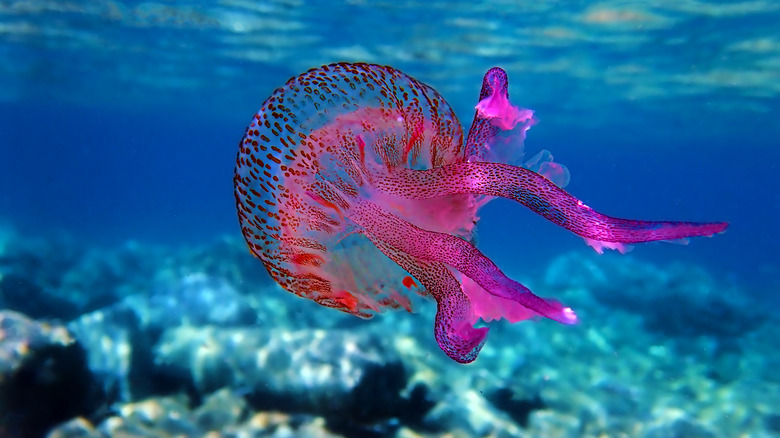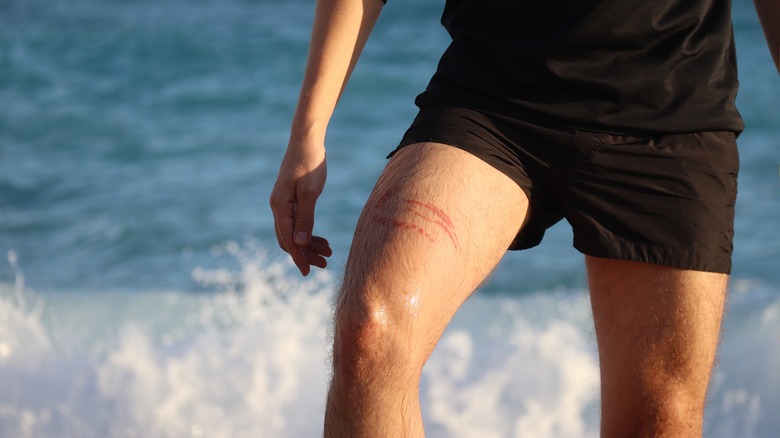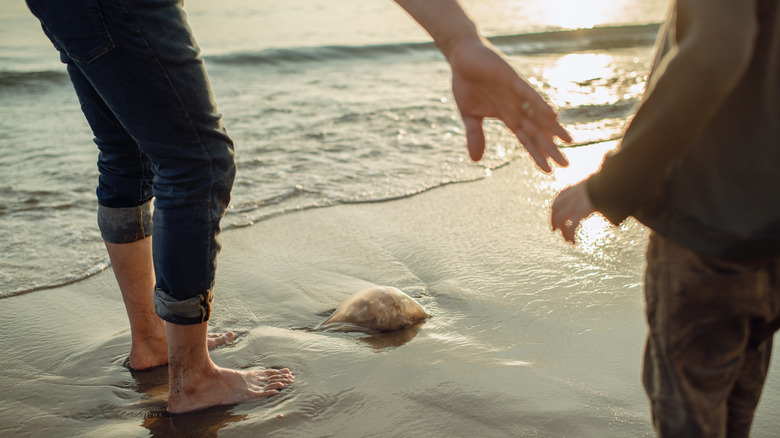What You Should Do If You Get Stung By A Jellyfish
The time has finally come to take that family trip to the beach that you've been planning all year. The sun is shining and the ocean looks beautiful, so you dive into the water and enjoy the crashing surf. Suddenly, you feel something move past your leg. You might decide it's just a piece of seaweed and it's nothing to worry about. After a few moments, however, the side of your leg starts to tingle and burn, and you realize what just happened. The long tentacle of a jellyfish has brushed past you, and you're starting to feel the effects of its sting. As you make your way out of the water to seek relief from the pain, your mind races as you consider all of the treatments you've heard about over the years, some more outrageous than others. However, the very best remedy for a jellyfish sting is to apply undiluted vinegar to the wound, followed by a hot water soak.
Dr. Tom Doyle is a biologist at the University of Galway in Ireland, who participated in a research study to determine what method worked best to alleviate the pain of a jellyfish sting, per The Guardian. He said that many theories had been discussed about how to treat jellyfish stings, and it was important to verify which one worked best. "We went back to basics and tested different methods. There's no doubt about our findings. We are absolutely 100% certain that vinegar does the trick," said Doyle.
How to treat a jellyfish sting
When addressing the nature of a wound from a jellyfish, it is important to understand how a jellyfish stings. These animals are invertebrates that are found in the world's oceans, often with long tentacles trailing behind them. The tentacles are covered with small capsules that pierce the skin and release a venom, causing irritation and a burning sensation. The challenge is how to remove the tentacles and dislodge the capsules without activating them further. While it may seem instinctive to grab the tentacles and pull them off, this hasty decision could prove to make things worse by injecting more venom into your skin. In addition, you can accidentally spread the rash to your hands by doing so. Even jellyfish that have washed ashore can deliver a potent sting if handled.
Various methods for treating a jellyfish sting, such as lemon juice, soap, alcohol, and yes, even urine, were found to be less effective than vinegar, and they could possibly expand the rash further. Vinegar will reduce the potency of the venom, and a hot water soak will reduce the effect of the stingers in the capsules. The hot water treatment should last at least 30 minutes, and the temperature of the water should be as high as possible. While it may seem counterintuitive to rinse the sore area with hot water, it is an effective treatment to deactivate the stingers as well as stimulate the circulation to increase healing time.
Create a first aid kit
After taking these steps, you can apply antibiotic ointment to the wound and hydrocortisone cream to address any itching. Over-the-counter pain relievers should help with the discomfort, and most injuries from jellyfish stings will heal after a week or so. However, if a brush with a jellyfish activates an allergic reaction, the situation can be much more serious. Many people don't realize they are allergic to the venom from a jellyfish until the first time they are stung. An allergic reaction can trigger symptoms such as hives, a racing heartbeat, or even difficulty breathing. If the victim experiences any of these symptoms, it's imperative to take the individual to an emergency room as soon as possible.
To help alleviate symptoms from a sting, create a small first aid kit that includes an oral antihistamine such as Benadryl to prepare for a potential allergic reaction. The kit should also include a small bottle of vinegar, a roll of gauze, gloves and fine tweezers to remove the tentacles, antibiotic cream, and a hydrocortisone cream. It's also important to scan the shoreline for any jellyfish that may have washed ashore, which would indicate their presence in the water. In addition, most public beaches will display a blue or purple warning flag when there are a large number of jellyfish in the water that day. By following these tips, you'll take the best precautions to ensure that your day at the beach is the best it can be.


